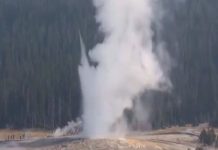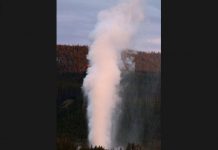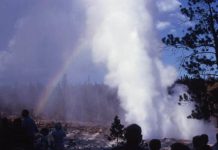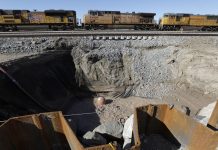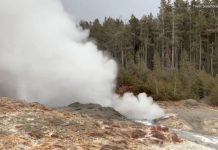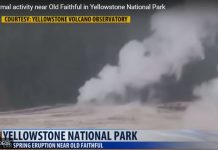It’s not something you normally see alongside a freeway… But, local Caltrans crews have been keeping a close watch on a geyser that’s impacting both the Union Pacific Railroad and State Route 111 near Niland in Imperial County. The challenge is that geyser is moving. Known as the Niland Geyser, it’s the only moving geyser in the world.
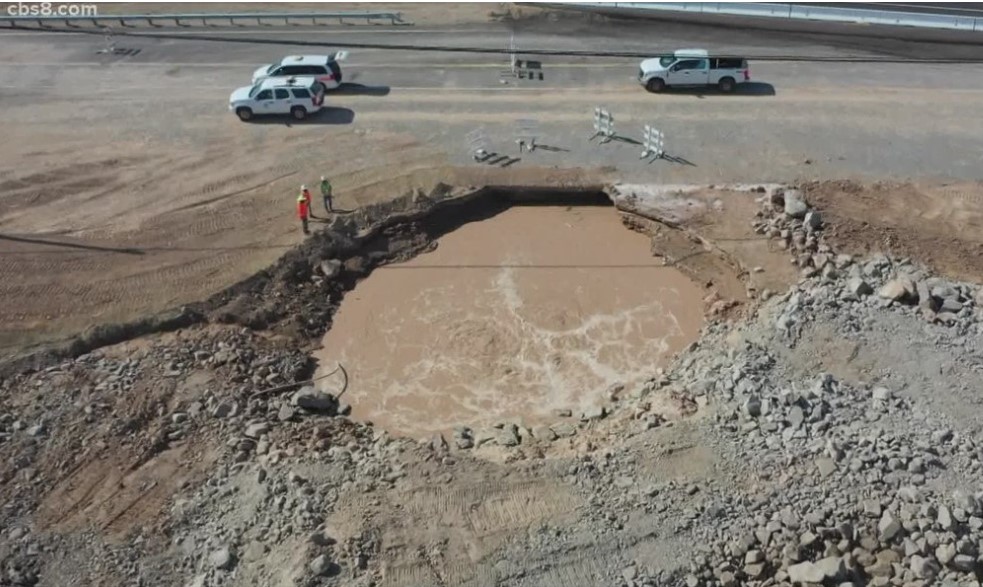
Some describe it as a bubbling pool of mud, often referring to it as a mud pot.
Shawn Rizzutto with Caltrans says the geyser is releasing CO2.
It’s been around since 1953. But, it didn’t start moving until 2016 following some seismic activity in the area.
“So, it’s been moving about 10 feet per month on average,” said Rizzutto.
He said the challenge is determining where it will go next.
“Right now, it’s been static for the past two and a half, three months, so it really hasn’t moved very much, but that could change in an instant,” Rizzutto said.
Caltrans officials considered several options, including a detour, which wasn’t ideal because it would have taken drivers 80 miles out of the way, and the 111 is crucial for the agriculture business there.
Instead, a temporary road was built parallel to the 111, wrapping drivers around the geyser.
“It’s 50 feet from our existing roadway, but it’s hundreds of feet from the new alignment we made for the detour,” Rizzutto said.
Sheet pile walls were also constructed, as well as a sub-surface drainage system to help control the water being emitted, which some scientists estimate is around 40,000 gallons a day.
“With that amount of water, it creates a quick zone which is liquefaction for an area from the surface to 40-50 feet in depth,” said Rizzutto.
Even with all those fixes, the geyser has the upper hand.
Initially moving southeast, it continued south, so Caltrans is now expanding the temporary roadway.
Their plan is to monitor the geyser until it moves far enough away to be able to repair the original 111 and make that a permanent road yet again for years to come. The cost of this project is around $19 million.
Caltrans officials said there is no danger to motorists, but, keep in mind, it’s not a tourist attraction. The area around the geyser is closed.
Still, it’s piqued a lot of people’s interest including geologists.
The Niland Geyser is a slow-moving disaster
The Niland Geyser first appeared in 1953, and sat around without incident for decades. Then, in 2016, the geyser started moving across dry ground at a glacial pace.
In the first 6 months, the Niland Geyser travelled 18.3 meters (60 feet). Then, it travelled another 18 meters in a single day. Overall, this bubbling puddle has moved roughly 80 meters (250 feet) from where it was a decade ago.
The source of the mud is located at the southern end of the San Andreas Fault, the boundary between the North American and Pacific tectonic plates.
According to specialists, the geyser’s presence and movement are not signs of seismic activity. A mud pot is associated with a tectonic boundary, but it’s actually a bit like a sinkhole (except full of, well, mud).
The Niland Geyser is a geothermic feature where water is forced upward through the soil. It’s not a very hot spring, with a temperature of only around 27 degrees Celsius (80 Fahrenheit); instead it’s bubbling with carbon dioxide gas that is also seeping up from deep under the ground, released by prior earthquake activity.
It also reportedly has a bit of a stench, smelling faintly of rotten eggs – not uncommon for underwater spring activity, due to the hydrogen sulfide in the water.
As it moves along through a soft sedimentary rock called mudstone, it leaves a soggy trail in its wake, weakening the integrity of the ground to a depth of about 9-12 meters (30-40 feet), making it boggy and unsuitable to support structures.
So there’s no need to worry that the long-awaited “Big One” earthquake is about to hit. The Niland Geyser is plenty enough to worry about without borrowing impending doom. [Nyland Geyser, CBS8]
Now subscribe to this blog to get more amazing news curated just for you right in your inbox on a daily basis (here an example of our new newsletter).
You can also follow us on Facebook and/ or Twitter. And, by the way you can also make a donation through Paypal. Thank you!
You should really subscribe to QFiles. You will get very interesting information about strange events around the world.




